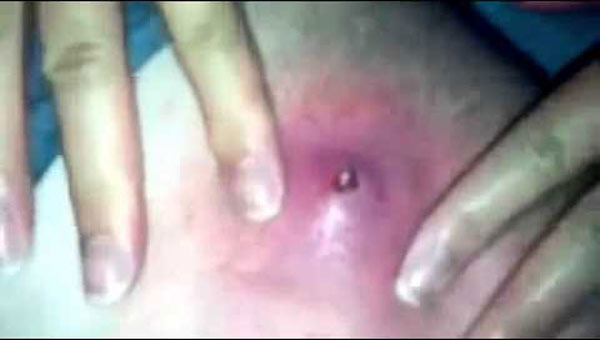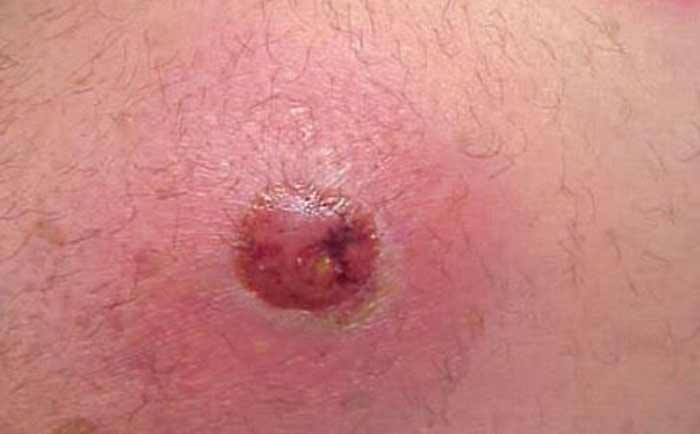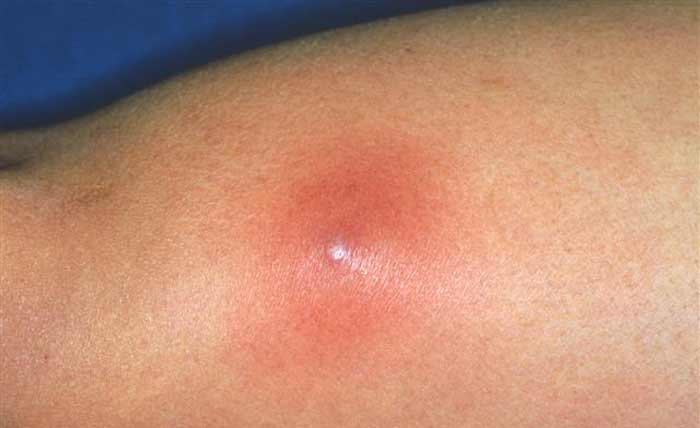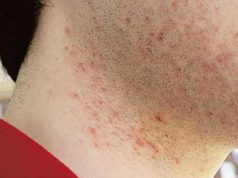Ingrown hair boils may be difficult to identify. It is usually a condition that has developed from an infected inward growing hair. Read on to find out how they come about, how they differ with boils, how to get rid, treatment options, home remedies and tips to prevent re-occurrence.
Ingrown Hair Boil + Pictures: Boil or Ingrown hair?
What is an Ingrown hair boil?
An ingrown hair boil is one that occurs due to hair follicles growing in the wrong direction; into the skin and resulting in inflammation around the follicle. This causes folliculitis.
They are common in areas on which shaving is common such as the scalp, the beard area in men, armpits and bikini line in women. It mostly affects young African-American men, particularly due to the typical texture they have of hair on their facial area. It is also common in men due to frequent shaving.
An ingrown hair does not guarantee an infection. It is in fact self-limiting if it is not infected. However, progression of this abnormality increases the possibility of an infection occurring. This results in the development of a boil.
How do boils relate with ingrown hairs? Ingrown Hair from Boils or Boils from Ingrown Hair
Ingrown hairs result in boils and therefore ‘boils from ingrown hair’. This is what happens:
- Causal factors of ingrown hair such as waxing, shaving or having curly hair result in inward growth of the hair shaft into the skin. Shaving leaves a sharp end on the hair which makes it relatively easier for the shaft to penetrate the skin.
- When the body reacts to the foreign object and the result of penetrating the dermis. An immune response is triggered and inflammation occurs. Inflammation is a physiological process and if not infected, it heals by itself.
- If an infection occurs, then an immune response is triggered and white blood cells are mobilized to the site with blood and the lump that forms is pus filled and red. It is painful and resultant scarring occurs if not attended to.
- Folliculitis develops into a furuncle which is a boil.
Ingrown Hair boil pictures
What is a Boil and how does it come about?
Boils are really painful but relatively easy to treat. They just require identification and within a jiffy, you are on medication and they will be gone in days.
Boils, cysts, styes, carbuncle, furuncle, name it and you’ve heard most if not all of these terms being used. Most people use them inter-changeably to refer to one and the same thing. They however bear slight differences and variations in perhaps their location and some characteristics.
A boil is an infection which occurs in the sin. It mostly starts in a hair follicle or an oil gland then complicates into the typical boil you might have seen. When the hair follicle it starts from inflames, it is known as folliculitis. What happens is the skin turns sore and inflamed.
The area becomes lumpy and tender (painful to touch). Give it about one week and the lump turns white and pus continuously collects under the skin. It starts superficial to the skin but as the days go by and the infection becomes extensive, it spreads to the deeper tissues of the skin. At this stage, it becomes an abscess know as a furuncle. An abscess is a painful collection of pus.
A boil is generally not contagious. However, the infection that has caused it may spread onto other breached parts of your skin or another person’s skin and result in a boil.
Types
There are various types of boils depending on where they may occur. The following are its types:
Furuncle
an abscess that forms around a hair follicle. It is the ‘typical boil’ people talk about and therefore this term can be used inter-changeably. The most common places for ingrown hair boils include the face, neck, shoulders, buttocks and armpits.
Stye
this is an ingrown hair boil that forms along the eyelid line or edge. When it occurs inside of the eyelid it is known as an internal hordeolum.
Hidradenitis suppurative(HS)
it is also known as acne inversa. The skin gains a cover of lumps under the skin that look like pimples. The lumps are generally purulent and therefore abscesses. HS usually begins in this manner but the pimples tend to develop in places on your body that everyday pimples do not appear.
It commonly is found in the under arms and groin occurring as jointed or series of abscesses. If the pimple-like bumps grow deep into the skin, it becomes very painful and attains a foul smell.
Carbuncles
this is a cluster of ingrown hair boils or furuncles that form in a connected manner as an area of infection under the skin. It occurs as a result of inflammation on more than one hair follicles.
Pilonidal cyst
this is an abscess that you will find occurring in the crease of the buttocks just close to the tail head.
Causes of Boils
There are a variety of causes of boils including:
Underlying health problems
There are heath conditions that make it easier for people to acquire infections such as in the case of:
- Immunosuppression – HIV/AIDS patients or those under immunosuppressive medication are susceptible to infections and therefore boils. Their immune system is not sufficient to trigger an appropriate response towards infectious critters. Illnesses such as iatrogenic (medication caused) bone-marrow depression, cancer or Cushing ’s syndrome result in suppression of immunity.
- Poor nutrition – malnutrition mostly manifests as tendency to get infected and not be able to fight back. You need immune boosters such as fruits and vegetables to fight infections.
- Exposure to harsh chemicals that irritate the skin – this creates a breach in the skin and allows infections to take root.
Other Causes include
- Ingrown hair
- Foreign material stuck in the skin e.g splinter (idiopathic)
- Clogged sweat glands
- Breach of skin/ cuts or tiny nicks
Ingrown Hair Boil Removal, Treatment & Home Remedies
How to get rid/Remove
Boils should resolve on their own but there are situations whereby you will need to seek medical attention. This is especially if you have a concomitant illness or condition such as diabetes.
If your boil is a pilonidal cyst, then this is a special circumstance and will require incision, drainage and packing with a gauze. This will continue to drain the boil.
Getting rid of a boil is dependent on the size and the firmness of the boil. You could choose to remove it at home, get treatment or have it drained in a health facility.
When the boil is firm and small, it would be zero work opening the area and attempting to drain it. You need to wait for it to become softer, form a head which is a small pustule and then drain it easily. If you try drain the boil before it softens, it would be injurious and may lead to an open wound that pre-exposes to infections.
Ingrown hair boils are generally smaller than expected in other sites. They however are able to drain themselves when they are soaked or heat is applied.
If it happens that you have a large ingrown hair boil, then it may need to be drained when a pustule or “lanced” by a health care professional.
Further Reading:
Treatment options
There are treatment options you could consider if your boil has a progression of infection or simply doesn’t go away. In some in can take a couple of weeks or more.
There are OTC medication such as:
Antibiotics – antibiotics will be prescribed based on the infectious bug in question. Most times you will be dealing with Staphylococcus aureus and you will need medication to which it is not resistant. Antibiotics are not needed in every situation and especially those that would need to penetrate the abscess outer wall. Draining is necessary first.
Pain alleviators – to relieve pain you could get ibuprofen or acetaminophen/paracetamol. It is worthwhile noting that while these drugs help relieve pain, they might mask infections by reducing the inflammation caused.
Home remedies
Most simple boils can be treated using home remedies. Treatment should start as soon as the boil is identified. The earlier the better. Some home remedies you could try includes using health application or warm compress method. This helps increase the flow of blood to the area affected and deliver more immune fighters. You could do this by following these steps:
- Make sure you properly clean your palms then rinse thoroughly.
- Dip a clean towel or pack into hot water.
- Hold some cotton wool in your hands.
- Place and hold the hot towel on the boil and its surrounding for some seconds then wait for it to soften.
- Using a sterilized pin, prick the boil. Makes sure you have some cotton wool in your hands.
- Drain the purulent discharge
- Clean the area well and use the cotton wool to prevent spreading the fluid to other parts.
Other remedies include:
- Applying ginger extracts
- Applying honey to the ingrown hair
- Applying diluted baking soda
- Applying apple cider vinegar
- Sugar scrub
- Lemon after shave scrub
Tips & Ideas to Prevent Ingrown Hair Boils
To prevent ingrown hair boils from occurring, use the following tips;
- Wet your hair thoroughly before shaving
- Use a sharp quality razor when shaving. Do not reuse disposable razors. You could also consider using an electric razor.
- Makes sure to use an aftershave cream or gel
- Shave toward the direction of your hair growth
- Make sure that after waxing, proper aftercare is done including using refreshing creams and exfoliating.
- Do not pop your ingrown hair cyst or boil as it may spread infections to other parts of the skin.
References: WebMD, Mayo Clinic, nhs.uk, MedicineNet, eMedicine






